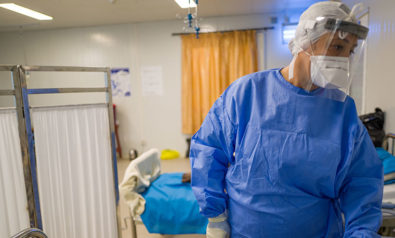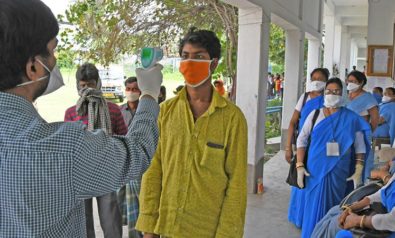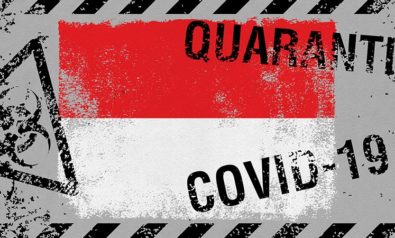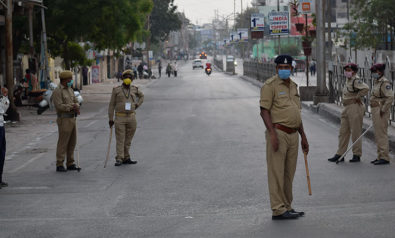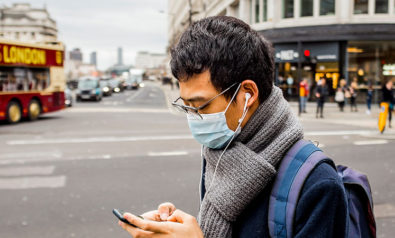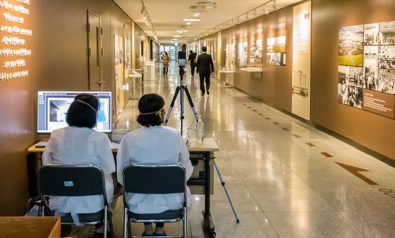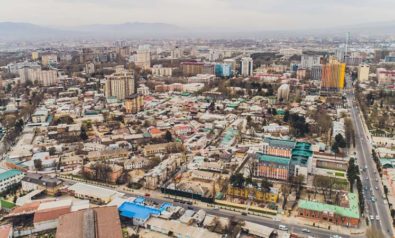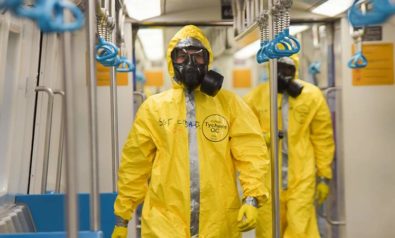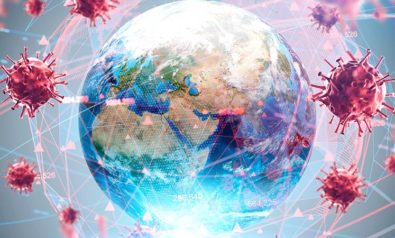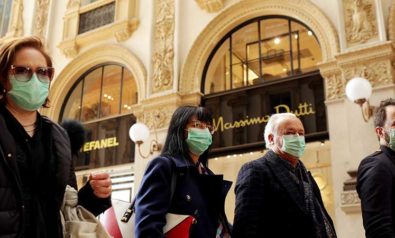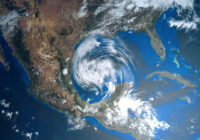There are many theories as to how COVID-19 began. Some of them are plausible, others are nonsensical. US President Donald Trump and Secretary of State Mike Pompeo have done their bit to fan such theories. Many in the world believe that the new coronavirus, SARS-CoV-2, was either released deliberately or leaked from a biological laboratory in Wuhan. On Fair Observer, three writers have three different points of view.
Daniel Wagner argues that horseshoe bats, the source of SARS-CoV-2, are not native to the Wuhan area. More importantly, they were not sold in the Wuhan seafood market, the place many scientists hold to be the source of the first infection. Importantly, both the Wuhan Institute of Virology and the Wuhan Center for Disease Control and Prevention had conducted research on horseshoe bats. So, the virus could have escaped from a laboratory and caused the COVID-19 pandemic.
Peter Isackson points out that Wagner is relying on circumstantial evidence. He quotes Dr. Anthony Fauci, the director of the National Institute of Allergy and Infectious Diseases, who takes the view that all signs indicate SARS-CoV-2 “evolved in nature and then jumped species.” It is highly unlikely that the virus could have escaped a laboratory. Isackson reminds readers that blaming a foreign power is an old game. The Americans have played it as well as anyone else. In the 1950s, J. Edgar Hoover and Joe McCarthy blamed communists for many of America’s ills. That distrust of communism remains. As a communist country, China is now the new Soviet Union. For many Americans, it is a national imperative to cut this evil power down to size.
What If the Next Pandemic Is Targeted?
John Feffer also counters the argument Wagner, Trump and Pompeo peddle. As he admits, “China could indeed be a great deal more transparent about its statistics, the origins of the virus and its response to the pandemic.” However, Trump and Pompeo have a vested interest in blaming China. It distracts voters from their monumental incompetence and allows them to pose as gallant patriots fighting a sinister rival. Trump has already claimed that China was raping the US and unleashed a trade war on the Middle Kingdom. He is portraying himself as the only one with cojones to take on the red fire-breathing dragon. So, he has a simple message: “To stop China, you have to stop Joe Biden.”
How Did COVID-19 Begin?
Most scientists hold COVID-19 is a classic example of cross-species transmission. A research paper in the Journal of Medical Virology examined the evidence to conclude that SARS-CoV-2 jumped from bats to pangolins to human beings at the seafood wholesale seafood market in Wuhan. In this wet market, many animals, including marmots, hedgehogs, frogs, snakes, bats, birds, poultry and other farm animals were also sold.
Pangolins are endangered scaly anteaters. Eating or trading them is illegal, yet they are one of the most trafficked mammals in the world. In China and Vietnam, pangolin meat is considered a delicacy, and its scales are supposed to have medicinal properties. Based on reported seizures, between 2011 and 2013, nearly 117 million pangolins were estimated to have been killed. Importantly, experts believe that seizures represent as little as 10% of the actual illegal pangolin trade.
The seafood market in Wuhan had several species in close proximity, making it a petri dish for new disease. Such wet markets are a key reason why “China has been the epicenter of emerging and re-emerging viral infections.” In the last 20 years, several viral diseases have emerged out of China, including the 1997 avian influenza, the 2003 severe acute respiratory syndrome (SARS) and the 2010 severe fever with thrombocytopenia syndrome (SFTS). COVID-19 is part of a recurring pattern. Some scientists are unsure that pangolins were the intermediary animal. Yet most are convinced that an intermediary was involved. The theory that the virus jumped directly from bats to humans in a laboratory has few takers among serious scientists.
The paper tells us that the Wuhan Municipal Health Commission (WMHC) reported 27 cases of viral pneumonia with seven critically ill on December 12, 2019. Most COVID-19 timelines begin from December 31 because the Chinese authorities initially downplayed the outbreak. Only on the last day of 2019 did Chinese authorities admit that they were treating dozens of cases of pneumonia of unknown cause.
On January 3, WMHC reported 44 cases with 11 in critical condition. Two days later, on January 5, the number of cases increased to 59, with seven critically ill. It turned out that the viral pneumonia outbreak was not caused by severe acute respiratory syndrome coronavirus (SARS‐CoV), Middle East Respiratory Syndrome coronavirus (MERS‐CoV), influenza virus or adenovirus. On January 7, Chinese authorities isolated SARS-CoV-2, the new type of coronavirus. Four days later, on January 11, the country reported the first death. On January 12, Chinese scientists publicly shared the genetic sequence of COVID-19.
It is absolutely certain that the virus originated in China as did many others in the recent past. Yet the evidence indicates that this is part of a pattern. The Chinese penchant for eating exotic meats and keeping many species in close proximity in their wet markets triggered this pandemic. It seems habits and conditions endemic to China, not mala fide intention or gross negligence on the part of a laboratory, triggered this pandemic.
What Do Past Pandemics Tell Us?
Epidemics have been the invisible killers of history. For the last 1,500 years, plague has continuously ravaged the world. It usually emanated from Africa or Asia and then spread to Europe and America thanks to globetrotting merchants. For instance, the Black Death wiped out up to one-third of the European population between 1334 and 1372. Plague kept returning intermittently until as recently as 1879.
In the early years, people thought of epidemics as divine wrath. To placate the angry deity, the people “cast out the supposed sinners, be they prostitutes, Jews, religious dissenters, foreigners, lepers, beggars, or accused witches.” They prayed at holy shrines and performed penitence. They sought intercessions through saints.
Not all relief came from religion. Through trial and error, cities figured out responses to epidemics. Bureaucrats, police and military authorities worked closely to isolate the ill in pest-houses or lock them up in their homes. They isolated the population with sanitary cordons “to prevent the inflow of disease-carrying people and goods.” Venice became the first city to quarantine ships and their crews. The word “quarantine” itself comes from the Italian quaranta, meaning “40,” and refers to the Biblical importance of the number in rituals of purification, like Lent. It is fair to say that the early anti-plague policies played a key role in the emergence of the modern state.
During World War I, H1N1 viruses with genes of avian origin caused an influenza that the US Centers for Disease Control and Prevention (CDC) deems “the most severe pandemic in recent history.” This 1918 pandemic lasted until 1920 and has become known in history as the Spanish flu. At that time, Spain was a neutral country. It had stayed out of the war and did not censor its press unlike France, the UK and the US that swept the bad news under the carpet. Since Spain became the first country to report the pandemic, it acquired the eponymous misnomer.
This pandemic affected an estimated 500 million people, a third of the then global population of 1.5 billion. The CDC estimates that 50 million died and reports that mortality was particularly high for those in the 20-40 age group. A well-known 2006 research paper, “1918 Influenza: the Mother of All Pandemics,” by Jeffrey Taubenberger and David Morens, explains that the pandemic came in three waves, of which the last two were more deadly. Unlike the previous 1889 influenza epidemic that was spread over three years, the 1918 H1N1 viruses had “the unprecedented ability to generate rapidly successive pandemic waves.”
These viruses were isolated “first from pigs and shortly thereafter from humans.” The origin of the pandemic continues to be debated. John Barry traces it to a farm in Kansas, the virologist John Oxford to a British troop staging and hospital camp in France and a third claim to northern China. Oxford’s thesis is regarded as the most credible. The British ran “15 or so hospitals” with 20,000 beds at Étaples. As the Germans launched chemical attacks, thousands of troops passed through the camp every day, the number rising to 100,000 at times. Villages supplied food, including pigs and poultry. In both Kansas and Étaples, the H1N1 virus jumped from birds to pigs to humans. British troops soon took the disease home and to the rest of the British Empire. Within six weeks of two troop ships docking in Cape Town, 300,000 South Africans were dead. Another troop transport brought the deadly flu to Mumbai. It spread like wildfire, killing an estimated 17 to 18 million Indians, about 6% of the population as undernourished people living in cramped, unhygienic conditions proved particularly vulnerable. More women died than men. The 48-year-old Mahatma Gandhi fell ill too but was lucky enough to survive.
Premature Hubris
At the time, there was no vaccine to protect against influenza infection and no antibiotics to treat secondary bacterial infections. Isolation, quarantine, good personal hygiene, use of disinfectants and limitations of public gatherings were applied unevenly. Although the pandemic began in Europe, the colonies ended up paying a heavier price.
For a few decades, the world escaped such a terrible pandemic. Vigorous vaccination programs and public health measures helped curb polio, typhoid, cholera, and even measles, which almost vanished in the West. This heady success made Harvard and Yale close their infectious disease departments by the 1970s. That hubris proved premature. Soon HIV/AIDS, SARS, MERS, Ebola, Zika, and avian and swine flu emerged.
Just like the 1918 pandemic, the 2009 swine flu was caused by a novel H1N1 virus. It emerged first in Mexico, was detected first in the US and quickly spread throughout the world. The CDC estimated 60.8 million cases, over 274,000 hospitalizations and nearly 12,500 deaths in the US alone. Globally, more than half a million might have died of the 2009 H1N1 virus. A key research paper calculated 11%-21% of the global population, up to a billion people, might have been affected.
The 2009 H1N1 virus proved less deadly than its 1918 predecessors but it served a warning that a global pandemic might be in the offing. Numerous experts sounded the alarm. Michael Osterholm, an American scientist from Minnesota, spent the last decade warning about a global pandemic and even co-authored a popular book on the subject. Stephen Morse, a professor at Columbia University, argued that humans were vulnerable “to new zoonotic health threats.” Simply put, zoonotic diseases are those that can be transmitted from animals to humans.
In a 2012 paper in The Lancet, Morse and his co-authors found that “the frequency with which new pathogens emerge is increasing.” Since 1940, 400 emerging infectious diseases have been identified. Of these, 60% are zoonotic. They tend to emerge in geographical regions or places where people, wildlife and livestock jostle interface closely. It is important to note that these emerging infectious diseases correlate “strongly with human population density.”
Morse and his fellow scientists hypothesize that the rise in zoonotic diseases is “driven by largely anthropogenic changes, such as the expansion of agriculture, travel routes, and trade, and changes in land use.” In other words, human changes to the environment are increasing risks of pandemics. Places with high human density and wildlife diversity are likely to be the next emerging zoonoses, the so-called hotspots of new infectious diseases. China with its huge population and exotic animals in its wet markets is the biggest hotspot. Africa with its fast-growing population and pressure on wildlife habitats is another one. So is the Amazon, where human encroachment is increasing risks of new disease.
What Does the Future Hold?
It took millions if not billions of years for immensely complex ecological systems to evolve. Population explosion, pollution and destruction of natural habitats are wreaking havoc on these systems. Climate change is posing a new threat. It is melting frozen permafrost soils. This is releasing ancient viruses and bacteria that have remained dormant in cold storage for thousands of years.
Most people do not realize that frozen permafrost soil is the perfect place for microbes and viruses to remain alive for very long periods of time. It is cold, dark and has no oxygen. In fact, some bacteria could even last a million years. Pathogenic viruses, including those that caused global epidemics, stay alive for long periods as well. The temperature in the Arctic Circle is rising three times faster than in the rest of the world. As Jasmin Fox-Skelly writes for the BBC, this melting ice “could potentially open a Pandora’s box of diseases.”
For centuries, people and animals have been buried in permafrost. They died of a host of diseases such as the 1918 influenza, smallpox and bubonic plague. In a 2011 paper, Boris Revic and Marina Podolnaya argued that “the vectors of deadly infections of the 18th and 19th centuries may come back, especially near the cemeteries where the victims of these infections were buried.” A classic example of this possibility is a Siberian town on the banks of Kolyma River. In the 1890s, 40% of its population died of smallpox. The dead were buried under the upper layer of permafrost on the banks of the river. Now, the river’s floodwaters are eroding its banks. The melting of the permafrost has speeded up this process. The risk of smallpox returning to Siberia, Russia and the rest of the world is increasing.
Scientists warn about another major risk. Extinct hominin species like Neanderthals and Denisovans settled in Siberia. They lived, sickened and died here for thousands of years. Naturally, they suffered from many diseases, bacterial and viral. Their remains from 30,000-40,000 years ago that have long remained under the permafrost are now starting to pop up. The risk that we could catch a virus from a long-extinct Neanderthal is going up by the day.
Pathogens cut off from humans are emerging not only from melting permafrost but also other places. In 2017, scientists “extracted long-dormant microbes from inside the famous giant crystals of the Naica mountain caves in Mexico — and revived them.” Even older bacteria have been found in the Lechuguilla Cave in New Mexico, 1,000 feet underground. They had been hidden from the earth’s surface for over 4 million years.
It turns out that many of these ancient bacteria are resistant to antibiotics. The microbes in New Mexico had “somehow become resistant to 18 types of antibiotics,” including some considered to be a “last resort” for fighting infections. In a related phenomenon, a 2011 study found that bacteria found in 30,000-year-old permafrost in the Beringian region between Russia and Canada was resistant to beta-lactam, tetracycline and glycopeptide antibiotics. This suggests that some of these ancient microbes could cause deadly pandemics. Our immune systems are unprepared for it and our existing drugs are unlikely to work.
Even as new diseases spread from unlikely places, existing ones could increase their footprint. As the earth warms, colder northern countries might start suffering from “southern” diseases like malaria, cholera and dengue fever. Extensive use of antibiotics over the decades in both domesticated animals and humans is making once-treatable infections difficult to cure. Over time, it has weakened human systems and strengthened pathogens. The risk of antibiotic-resistant infections has turned serious and global. At the heart of the matter is a simple phenomenon: Humans have played god for far too long. They have recklessly abused the environment they live in. Unless humans change the way they live, nature will extract its own sweet revenge in a recurring wave of pandemics before too long.
The views expressed in this article are the author’s own and do not necessarily reflect Fair Observer’s editorial policy.
Support Fair Observer
We rely on your support for our independence, diversity and quality.
For more than 10 years, Fair Observer has been free, fair and independent. No billionaire owns us, no advertisers control us. We are a reader-supported nonprofit. Unlike many other publications, we keep our content free for readers regardless of where they live or whether they can afford to pay. We have no paywalls and no ads.
In the post-truth era of fake news, echo chambers and filter bubbles, we publish a plurality of perspectives from around the world. Anyone can publish with us, but everyone goes through a rigorous editorial process. So, you get fact-checked, well-reasoned content instead of noise.
We publish 2,500+ voices from 90+ countries. We also conduct education and training programs
on subjects ranging from digital media and journalism to writing and critical thinking. This
doesn’t come cheap. Servers, editors, trainers and web developers cost
money.
Please consider supporting us on a regular basis as a recurring donor or a
sustaining member.
Will you support FO’s journalism?
We rely on your support for our independence, diversity and quality.



